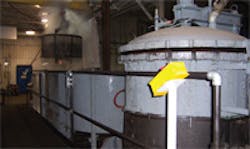Oberdorfer LLC, an aluminum permanent-mold and no-bake foundry added a new vacuum impregnation process that complies with the rigid specifications for military orders — and performs work that previously had to be outsourced.
The Syracuse, NY, foundry supplies highly engineered cast aluminum component parts to aviation, transportation, utilities, aerospace, military, high-performance automotive and medical systems markets.
Oberdorfer expects that the new impregnation process will increase its yield for sealed aluminum castings, resulting in fewer product problems in use. The system uses Anaseal HC90 Thermal Cure, a detergentfree product that washes easily in water.
Anaseal impregnation resins, supplied by Chemence Inc. seal microporosity into castings, powder metal parts, ceramics, and other porous substrates. Chemence is a primary manufacturer of high-specification adhesives and sealants for industrial and consumer markets, with facilities in the U.K., U.S., and South Africa.
According to Chemence, Anaseal HC90 sealant is specially formulated for ease of use and simplicity of process. It requires minimum sealant/process maintenance while providing high yields of sealed castings and other porous metal components.
Oberdorfer purchased a used wet-vacuum impregnation line and modified it to comply with MIL STD-17563C. The revamp included a complete reworking of its wiring and control system. The line consists of four stations: vacuum tank, centrifuge, rinse tank, and curing tank.
The process begins when a basket of castings is immersed in the impregnation resin in the vacuum tank. The tank is sealed and a vacuum drawn. During this step, all air is withdrawn from any porosity in the castings.
Then the vacuum is released and the tank is vented to atmospheric pressure. Parts are allowed to soak briefly while sealant fills the porosity. After 10 minutes for the vacuum treatment, the basket is moved to the centrifuge, for removal of excess resin, and so on through the rinse and curing steps. Resin is reclaimed from the centrifuge tank and vacuumed automatically back into impregnation tank.
The process handles castings as large as 4 ft., in circumference or in length. Several smaller-size castings are treated in a batch. Ninety percent of all castings that Oberdorfer produces are impregnated on the new line.
The system has sufficient capacity that Oberdorfer will perform impregnation services for any aluminum manufacturer interested in improving its yield percentage. Oberdorfer continues to invest in lean manufacturing with programs to advance and improve product quality and eliminate inventory overstocking for its customers. Recently,
Oberdorfer completed the installation and start-up of a thermal sand reclamation system. The system was designed to allow the foundry to recycle chemically bonded mold and core sands after use. The company believes the addition of the system, with capacity of 36 tons/day, will allow full reuse of all sands in its aluminum nobake and semipermanent molding processes.
